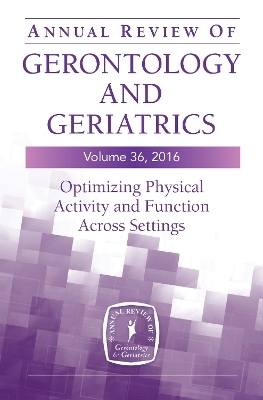
Annual Review of Gerontology and Geriatrics, Volume 36, 2016
Springer Publishing Co Inc (Verlag)
978-0-8261-9815-0 (ISBN)
"It is with great pleasure that I encourage you all to read and share the amazing wealth of information provided in this edition of The Annual Review of Gerontology ÖThis volume brings together an incredible amount of work in the area of physical activity and specifically exercise, and the challenges we face in engaging older adults in optimal amounts and intensities of activity. The authorsÖhave done a remarkable job of highlighting practical ways to share information that is known to be effective from research trials and clinical practice."
-Kathleen Mangione, PhD, PT, GCS
From the Foreword
The 36th Annual Review of Gerontology and Geriatrics is replete with state-of-the-art scholarship along with a cornucopia of research-based and innovative strategies for optimizing function in older adults through exercise and physical activity. Chapters address salient clinical, programmatic, and policy considerations related to implementation and dissemination of exercise programs across a variety of settings.
An international cadre of expert nurses, physicians, physical therapists, and exercise physiologists, among other health care professionals, also focus on what is known about specific exercises for older adultsóincluding benefit versus harm associated with each--and provide recommendations for their practical use.
The book addresses public policy related to exercise and how policy affects physical activity among older adults. It considers evidence linking physical activity to positive outcomes along with practical issues such as pre-exercise screening and risk stratification. Chapters cover aerobic, resistance, balance, and stretching exercises, along with recommendations for individuals suffering from specific diseases such as arthritis or dementia. Also addressed is physical activity as a determinant of health, and cross-setting approaches to increase function and physical activity. Of particular value is the attention given to the challenges of actually getting individuals to partake in exercise recommendations along with solutions on how to overcome these challenges. With a focus on helping adults to "be active in their own way," the authors share positive approaches to motivating and educating this population.
Key Features:
Presents state-of-the-art scholarship regarding ways to promote physical activity among older adults
Written by national and international experts
Focuses on aerobic, resistance, balance, and stretching exercises along with recommendations for people with impairments
Describes real world applications across multiple disciplines and settings
Offers strategies for overcoming resistance to exercise
Barbara Resnick, PhD, CRNP, FGSA, FAANP, FAAN, is Professor, Department of Organizational Systems and Adult Health, University of Maryland School of Nursing, and co-directs the Adult/Gerontological Nurse Practitioner Program and the Biology and Behavior Across the Lifespan Research Center of Excellence. She holds the Sonya Ziporkin Gershowitz Chair in Gerontology, and does clinical work at Roland Park Place. Marie Boltz, PhD, RN, GNP-BC, FGSA, FAAN, is the Elouise Ross Eberly and Robert Eberly Endowed Chair Professor, Penn State College of Nursing, where she teaches both gerontological nursing and PhD courses. She is a gerontological nurse consultant at the Hospital of the University of Pennsylvania, the Office of Inspector General, and the Department of Justice, and a senior nurse scientist at the Munn Center for Nursing Research, Massachusetts General Hospital.
Section One: Policy and Practice Related to Exercise and Function
1. The Impact of Policy on Exercise Activity and Where We Need to Go
2. Physical Activity Versus Exercise: Is Screening Necessary?
3. Consensus of Evidence Based Risk Assessment
4. Behavior Change
Section Two: Aerobic Exercise
1. Recommendations for Older Adults: What, Where, When and How
2. Benefits of Aerobic Exercise for Older Adults
3. Innovative Approaches to Exercise Among Older Adults
Section Three: Resistance Exercise
1. Resistance Exercise to Prevent and Manage Sarcopenia
2. Resistance Exercise: Slow Movement Versus Balistic Training
3. Resistance Exercise: Recommendations for Age Relevant Benefits
Section Four: Balance Exercise
Section Five: Stretching Exercise
1. Benefits Versus Harm to Stretching Pre or Post Exercise
2. Dynamic versus Static Stretching and Training to Task
Section Six: Incorporating Function and Physical Activity Across All Settings
1. Incorporating Function and Physical Activity Across All Settings
| Zusatzinfo | 10 Illustrations; 10 Illustrations |
|---|---|
| Verlagsort | New York |
| Sprache | englisch |
| Maße | 152 x 229 mm |
| Themenwelt | Geisteswissenschaften ► Psychologie ► Entwicklungspsychologie |
| Medizin / Pharmazie ► Medizinische Fachgebiete ► Geriatrie | |
| Medizin / Pharmazie ► Pflege ► Altenpflege | |
| Studium ► Querschnittsbereiche ► Prävention / Gesundheitsförderung | |
| Sozialwissenschaften ► Soziologie | |
| ISBN-10 | 0-8261-9815-5 / 0826198155 |
| ISBN-13 | 978-0-8261-9815-0 / 9780826198150 |
| Zustand | Neuware |
| Haben Sie eine Frage zum Produkt? |
aus dem Bereich


